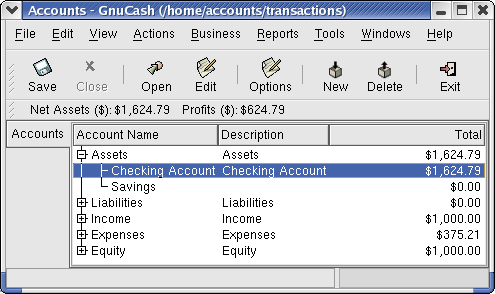In the previous sections of this chapter the concepts and mechanics of working with transactions in GnuCash has been discussed. This section will expand upon the chart of accounts initially built in the previous chapter.
Start by opening your chart of accounts file. Assuming you have been following the progress of this example chart of accounts, you should have 3 transactions already saved within the checking account. The main window should look something like this:

This image shows the starting point for this section.
As shown earlier with the Asset:Checking account, the starting balances in an account are typically assigned to a special account called Equity:Starting Balances. To start filling in this chart of account, begin by setting the starting balances for the accounts. Assume that there is $1000 in the savings account and $500 charged on the credit card.
Open the Assets:Savings account register. Select View -> Style from the menu and check to make sure you are in Basic Ledger style. You will view your transactions in the other modes later, but for now let's enter a basic transaction using the basic default style.
From the Asset:Savings account register window, enter a basic 2 account transaction to set your starting balance to $1000, transferred from Equity:Starting Balances. Remember, basic transactions transfer money from a source account to a destination account. Record the transaction (press the 'enter' key, or click on the 'enter' icon).
From the Asset:Checking account register window, confirm that you have already set the starting balance to $1000, transferred from Equity:Starting Balances. This should already have been done previously from the example earlier in this chapter, but if not, do so now.
From the Liabilities:Visa account register window, enter a basic 2 account transaction to set your starting balance to $1000, transferred from Equity:Starting Balances. This is done by entering the $500 as a "decrease", since it is money you borrowed. Record the transaction (press the 'enter' key, or click on the 'enter' icon).
You should now have 3 accounts with opening balances set. Assets:Checking, Assets:Savings, and Liabilities:Visa.
Now add some more transactions to simulate a month's expenses. During the month, $78 is spent on electricity, $45 on phone, and $350 on rent. All paid by check. Finally, let's move $100 from the savings account to the checking account.
Open the Expenses:Electricity account register and enter a simple 2 account transaction to pay the $78 electrical bill at the end of the current month (eg: June 30, 2003). Enter a description (eg: Light Company) and the check number (eg: 101). The Transfer account should be Assets:Checking.
Open the Assets:Checking account register and enter a simple 2 account transaction to pay the $45 phone bill at the end of the current month (eg: June 30, 2003). Enter a description (eg: Phone Company Name) and the check number (eg: 102). The Transfer account should be Expenses:Phone. Notice that you can enter expense transactions from either the credit side (the expense accounts) or the debit side (the asset account).
Open the Expenses:Rent account register and enter a simple 2 account transaction to pay the $350 in rent at the end of the current month (eg: June 30, 2003). Enter a description (eg: June Rent) and the check number (eg: 101). The Transfer account should be Assets:Checking.
Duplicate this transaction using the Duplicate button in the tool bar. Start by clicking on the current rent transaction, and click on the Duplicate icon. Enter the transaction date a month out in the future (eg: July 31, 2003) and set the check number (eg: 102), and notice the blue line separator that GnuCash uses to separate future transactions from current ones. In this way, you can enter transactions before they occur.
You could also set up a scheduled transaction to pay your rent, since the value of the rent is likely to be constant for the foreseeable future. FIXME, add scheduled transaction stuff.
To transfer money from you savings account to your checking account, open the Assets:Savings account register, add a new transaction setting the Transfer to Assets:Checking in the amount of $1000.